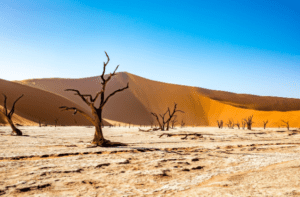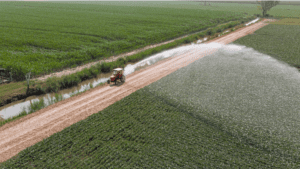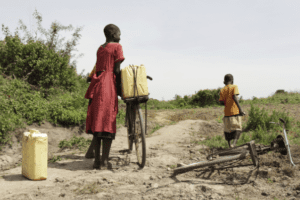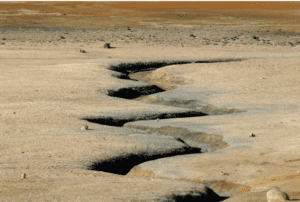Water usage on the international stage
The UN estimates that 72% of all water used is in agriculture. A further 16% is used by local communities for example, through domestic supplies. The final 12% is used in industry.
Water scarcity and child poverty
Of the basic necessities which are taken into account by organisations like the World Bank to help reach a multi-dimensional definition of child poverty, a safe water supply is as fundamental as it gets.
Many people are affected by drought every year
The World Health Organisation (WHO) estimates that approximately 55 million people around the world are affected by drought every year. Some of the most vulnerable work in agriculture and its associated trades. Droughts are obviously hazardous to livestock and crops everywhere. Depending on their severity, water shortages lead to people’s livelihoods being jeopardised or wiped out. The wellbeing of families and communities can be compromised if crops fail, or animals die from thirst. At its worst, drought can lead to whole communities migrating in search of safer, more reliable water supplies.
 Many people are affected by water scarcity
Many people are affected by water scarcity
Water scarcity impacts on about 40% of the global population, or 3.5 billion people.
A definition of water stress
Water stress is defined by assessing when a region or community draws on more than a quarter of its renewable freshwater supply. This is an initial red line intended to trigger a roll out of appropriate measures, official alerts and messages.
About 800 children under the age of five die every day because they are suffering from diarrhoea which has arisen from being forced to drink dirty water. Approximately 2.3 billion people do not have access to basic facilities such as a toilet.
Many people face the threat of forced migration because of drought
The WHO estimates that during the next seven years, as many as 700 million people, or one twelfth of the world’s population, will remain at risk of forced migration due to the threat of drought. Across the globe, approximately 2.2 billion people, or about a quarter of the global population, do not have access to a reliable and safe water supply.
 Water scarcity is becoming more commonplace
Water scarcity is becoming more commonplace
The UN considers that the effects of climate change are making water sources less reliable. Natural water storage – that is, water which is retained in the soil, or in ice and snow – is decreasing. This inevitably leads to mounting pressure points on resources, meaning interruptions to supplies. Consequently, in dry seasons widespread disruption across communities, agriculture and industry becomes inevitable.
Those likely to be hardest hit by water scarcity
People who live in poverty, in low income countries, and on the fringes of their societies are most commonly affected by even minor fluctuations in water supplies. When it comes to a crisis brought on by a natural disaster or political unrest, women and children are, as a rule, the hardest hit group. Responsibility for fulfilling family requirements tends to fall on women and children. For water scarcity translates into a practical, pressing need to collect water. This is a laborious task, even if water can be sourced locally, and can use up much energy and time on a daily basis. For children it may mean that they have no choice but to miss school.
 Helping to establish safe water supplies
Helping to establish safe water supplies
Organisations like Oxfam introduced rolling programmes to supply water storage tanks as long ago as 1976. These are obviously transformative because they can be used as a central depot and distribution centre.
Another key piece of equipment in the fight to establish safe water supplies is the testing kit. This needs to be lightweight, and easy to store, transport and use. Kits should be able to confirm that water is uncontaminated and has appropriate levels of chlorine.
The jerry can is still an important resource in the battle to provide emergency supplies of safe water. Sizes vary but an optimum measure is 20 litres, enough to permit people to carry them while providing enough water for domestic use for a few days.
Other essential equipment includes pipe work, taps, standpipes, tanks and toilets.
Further medium term help
While pumping water to many communities is a medium-term goal, installing irrigation systems for use in agriculture is also vitally important. This will not only preserve crops and livestock, it will also help to secure livelihoods.
Moreover, advice and information need to be made available to as many people as possible. One route to achieving this lies in reaching out to communities through schools.
The importance of data in controlling water scarcity
In many countries there is no established, official monitoring system in place to facilitate a water management programme. This is important to help strategic considerations and provide accurate updates. Monitoring schemes can help to balance community, agricultural and industrial needs.
What is the best way ahead?
The UN argues for a collaborative approach. There is a need to view water as a scarce resource. There is an increasing onus on the global community to introduce Integrated Water Resources Management Schemes (IWRMS). These should empower policy makers with a framework to align the requirements of various water users in light of supply and usage patterns and projected demands. They provide up to date insight to help assess levels of water reserves. Essentially, data help to control water scarcity. 
How can IWRMS control water scarcity?
Data monitoring arising from IWRMS is able to shed light on issues such as losses and leaks from water distribution infrastructure. Moreover, data monitoring enables better allocation of water resources and targeted deployment of repair and relief measures. A desalination programme may become a viable strategy which could be endorsed and focussed by findings from IWRMS. Appropriate safe recycling of grey water is a further issue which can be explored through the implementation of IWRMS. Such systems give greater control of water resources through more accurate assessments.
Other measures to address water stress
Awareness, communication and appropriate technology all contribute to the production of more accurate data relating to levels of water reserves and associated resources. This in turn can be augmented through educational programmes and media alerts, explaining the benefits of water-saving and the use of green practices, particularly within industrial and agricultural contexts. Any methods which help people to appreciate the need to promote sustainable use, conserve water and reduce waste will benefit everyone.
Sustainable use of groundwater is vital to ensure that communities in vulnerable areas can adapt to the impact of climate change and better manage the needs and demands of an expanding population.
Water relief
WaterAid describes the visibly lifechanging sense of relief when a community is supplied with a safe, reliable freshwater supply. Clean water, decent sanitary and toilet facilities together with beneficial hygiene practices are fundamental to ending the relentless cycle of child poverty across the globe. When an NGO like WaterAid oversees the installation of a well, or a standpipe, children benefit immeasurably. And not just by being released from water collection duties which support the family. Aiming to guarantee a fresh water supply, rationalise usage, pool expertise, and implement conservation measures will contribute hugely in the ongoing fight to end child poverty.


